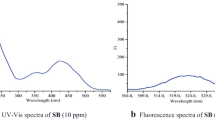Abstract
The Berthelot reaction is a classic method for detection of ammonium (NH4+) and atmospheric ammonia (NH3) by using salicylic acid (SA) as the chromogenic substrate. However, there lacks a method for improving the activity of the Berthelot reaction to enhance the analytical performance for detection of NH4+ and NH3. Here, five SA analogues with electron-withdrawing groups (-F) and electron-donating groups (-CH3 and -OCH3) at different positions of the aromatic ring have been chosen as the alternative to SA for Berthelot reaction. Among these analogues, 4-methoxysalicylic acid (4-OCH3-SA) shows the best colorimetric response and color change at a NH4+ concentration of 30 μM, and the sensitivity of 4-OCH3-SA-based colorimetric assay for NH4+ increases 1.75-fold compared with that of SA-based colorimetric method. This enhancement effect is attributed to the strong electron-donating property of 4-OCH3 group, activating the two-step electrophilic aromatic substitution reaction in the Berthelot reaction. Additionally, visual and sensitive detection of NH3 is realized, along with a low limit of detection down to 0.037 ppm. Furthermore, we demonstrate that this assay is reliable and practical for detection of NH4+ and NH3 in real water and air samples with good accuracy.





Similar content being viewed by others
References
Liu M, Huang X, Song Y, Tang J, Cao J, Zhang X, et al. Ammonia emission control in China would mitigate haze pollution and nitrogen deposition, but worsen acid rain. P Natl Acad Sci. 2019;116:7760–5.
Guo H, Otjes R, Schlag P, Kiendler-Scharr A, Nenes A, Weber RJ. Effectiveness of ammonia reduction on control of fine particle nitrate. Atmos Chem Phys. 2018;18:12241–56.
Bai Z, Winiwarter W, Klimont Z, Velthof G, Misselbrook T, Zhao Z, et al. Further improvement of air quality in China needs clear ammonia mitigation target. Environ Sci Technol. 2019;53:10542–4.
Zhang X, Gu B, van Grinsven H, Lam SK, Liang X, Bai M, et al. Societal benefits of halving agricultural ammonia emissions in China far exceed the abatement costs. Nat Commun. 2020;11:1–10.
Wu Y, Gu B, Erisman JW, Reis S, Fang Y, Lu X, et al. PM2.5pollution is substantially affected by ammonia emissions in China. Environ Pollut. 2016;218:86–94.
Remiszewska E, Malecha K, Kruk J, Jankowska-Śliwińska J, Torbicz W, Samluk A, et al. Enzymatic method of urea determination in LTCC microfluidic system based on absorption photometry. Sensor Actuat B-Chem. 2019;28:375–84.
Lin K, Zhu Y, Zhang Y, Lin H. Determination of ammonia nitrogen in natural waters: Recent advances and applications. Trends Environ Anal Chem. 2019;24:e00073.
Huang X, Li X, Li Y, Yang J, Tao C. Trace dissolved ammonia sensor based on porous polyelectrolyte membrane-coated thin-core fiber modal interferometer. Sensor Actuat B-Chem. 2016;226:7–13.
Nielander AC, McEnaney JM, Schwalbe JA, Baker JG, Blair SJ, Wang L, et al. A versatile method for ammonia detection in a range of relevant electrolytes via direct nuclear magnetic resonance techniques. ACS Catal. 2019;9:5797–802.
Forbes P. Atmospheric chemistry analysis: A review. Anal Chem. 2020;92:455–72.
Cuartero M, Colozza N, Fernández-Pérez BM, Crespo GA. Why ammonium detection is particularly challenging but insightful with ionophore-based potentiometric sensors-an overview of the progress in the last 20 years. Analyst. 2020;145:3188–210.
Zhu Y, Chen J, Yuan D, Yang Z, Shi X, Li H, et al. Development of analytical methods for ammonium determination in seawater over the last two decades. TrAC-Trend Anal Chem. 2019;119:115627.
Krom MD. Spectrophotometric determination of ammonia: a study of a modified Berthelot reaction using salicylate and dichloroisocyanurate. Analyst. 1980;105:305–16.
Daridon A, Sequeira M, Pennarun-Thomas G, Dirac H, Krog JP, Gravesen P, et al. Chemical sensing using an integrated microfluidic system based on the Berthelot reaction. Sensor Actuat B-Chem. 2001;76:235–43.
Cho YB, Jeong SH, Chun H, Kim YS. Selective colorimetric detection of dissolved ammonia in water via modified Berthelot’s reaction on porous paper. Sensor Actuat B-Chem. 2018;256:167–75.
Yao HB, Gao MR, Yu SH. Small organic molecule templating synthesis of organic-inorganic hybrid materials: their nanostructures and properties. Nanoscale. 2010;2:322–34.
Luo Z, Ma R, Chen Z, Xiao Y, Zhang G, Liu T, et al. Altering the positions of chlorine and bromine substitution on the end group enables high-performance acceptor and efficient organic solar cells. Adv Energy Mater. 2020;10:2002649.
Heo J, Ahn H, Won J, Son JG, Shon HK, Lee TG, et al. Electro-inductive effect: Electrodes as functional groups with tunable electronic properties. Science. 2020;370:214–9.
Zhang X, Gu B, Grinsven HV, Shu KL, Chen D. Societal benefits of halving agricultural ammonia emissions in China far exceed the abatement costs. Nat Commun. 2020;11:4357.
Pulido A, Ruisánchez I, Boqué R, Rius FX. Estimating the uncertainty of binary test results to assess their compliance with regulatory limits. Anal Chim Acta. 2002;455:267–75.
Lloret SM, Andrés JV, Legua CM, Falcó PC. Determination of ammonia and primary amine compounds and Kjeldahl nitrogen in water samples with a modified Roth's fluorimetric method. Talanta. 2005;65:869–75.
Funding
We received financial support of the National Natural Science Foundation of China (41831285).
Author information
Authors and Affiliations
Corresponding author
Ethics declarations
Conflict of interest
The authors declare no competing interests.
Research involving human participants and/or animals
The authors declare that no human participants and/or animals were involved in this research.
Additional information
Publisher’s note
Springer Nature remains neutral with regard to jurisdictional claims in published maps and institutional affiliations.
Supplementary Information
ESM 1
(DOCX 747 kb)
Rights and permissions
About this article
Cite this article
Yu, H., Zhang, G., Cai, Y. et al. Altering the substituents of salicylic acid to improve Berthelot reaction for ultrasensitive colorimetric detection of ammonium and atmospheric ammonia. Anal Bioanal Chem 413, 5695–5702 (2021). https://doi.org/10.1007/s00216-021-03485-3
Received:
Revised:
Accepted:
Published:
Issue Date:
DOI: https://doi.org/10.1007/s00216-021-03485-3




